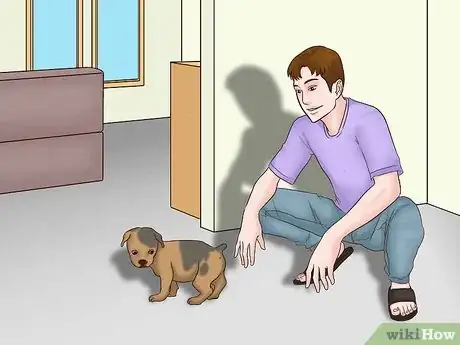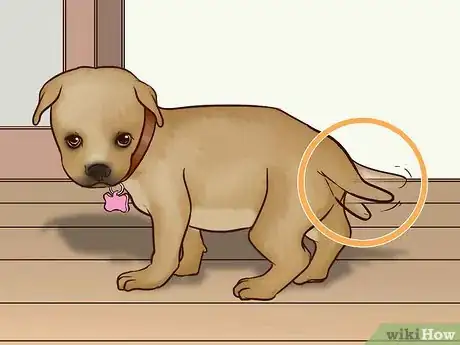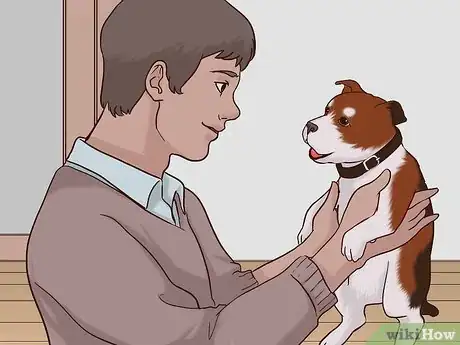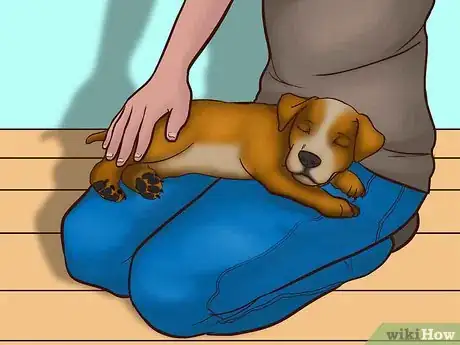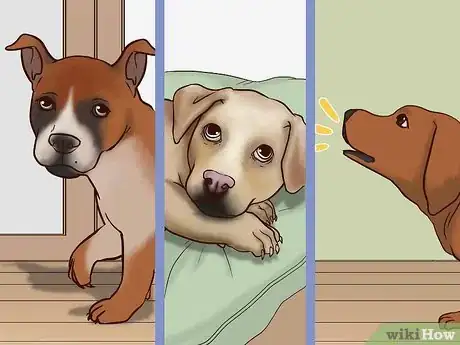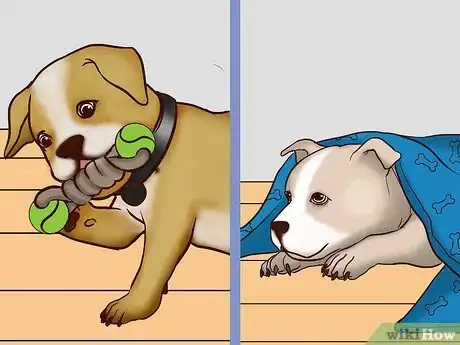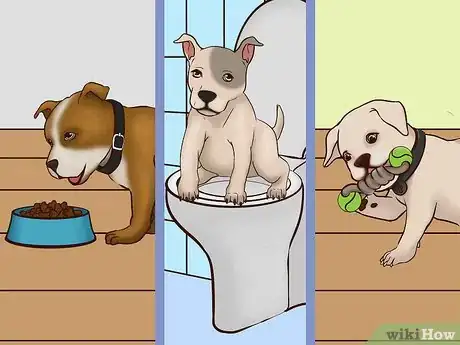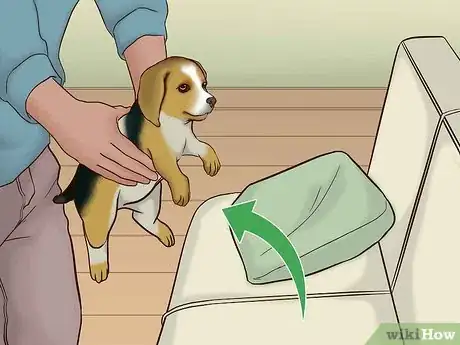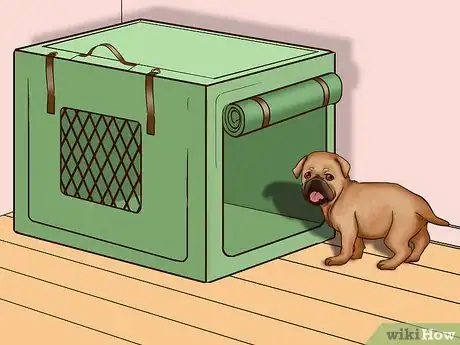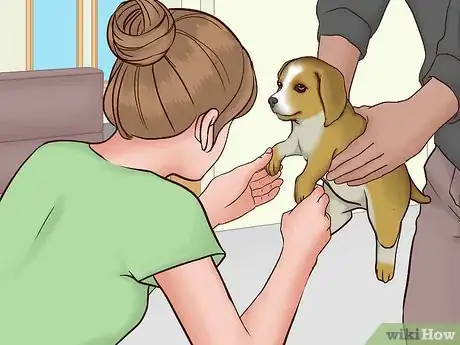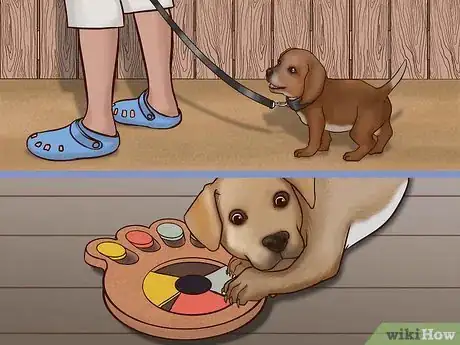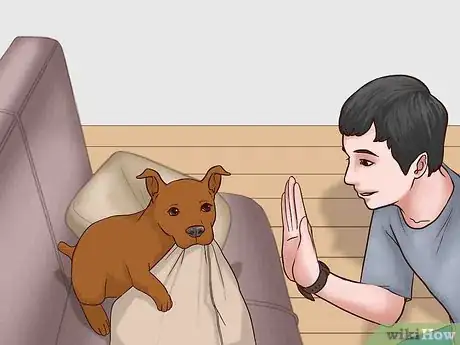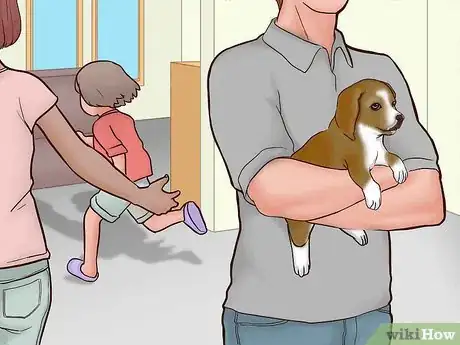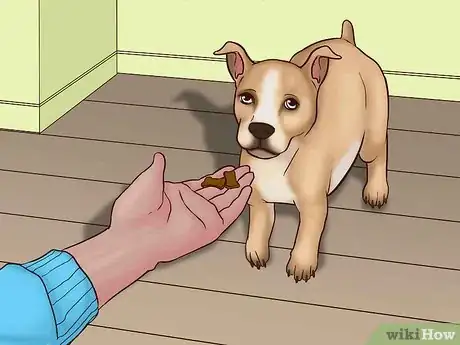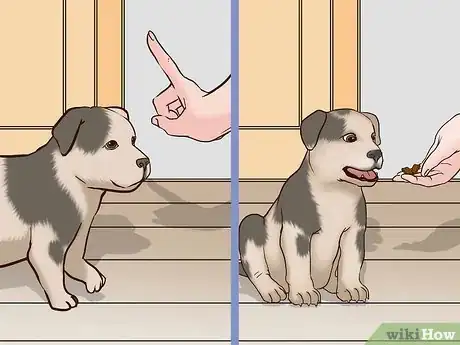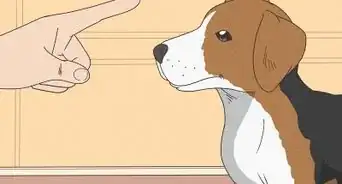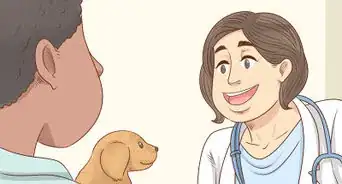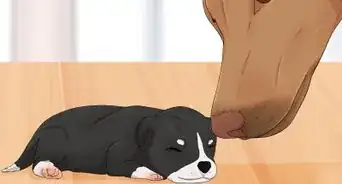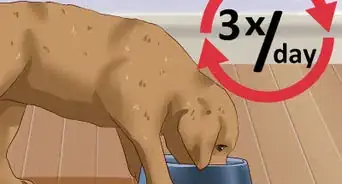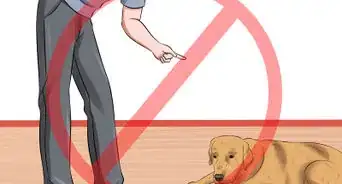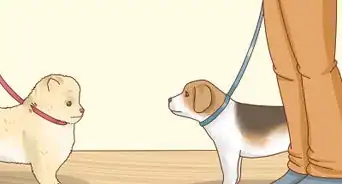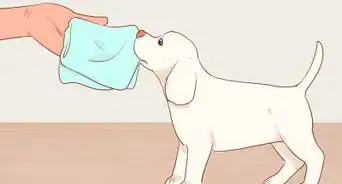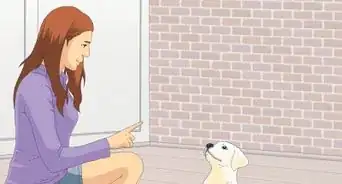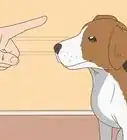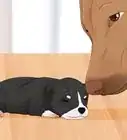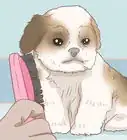This article was co-authored by Beverly Ulbrich. Beverly Ulbrich is a Dog Behaviorist and Trainer and the Founder of The Pooch Coach, a private dog training business based in the San Francisco Bay Area. She is a Certified CGC (Canine Good Citizen) Evaluator by the American Kennel Club and has served on the Board of Directors for the American Humane Association and Rocket Dog Rescue. She has been voted the best private dog trainer in the San Francisco Bay Area 4 times by SF Chronicle and by Bay Woof, and she has won 4 "Top Dog Blog" awards. She has also been featured on TV as a dog behavior expert. Beverly has over 18 years of dog behavior training experience and specializes in dog aggression and anxiety training. She has a Master of Business Administration from Santa Clara University and a BS from Rutgers University.
There are 11 references cited in this article, which can be found at the bottom of the page.
This article has been viewed 53,602 times.
Do you have a new furry friend, and do you want to ensure it’s as happy as possible? Adjusting to new surroundings takes time, and it’s normal if your puppy is nervous when you first take it home. Fortunately, puppies are adaptable, and there are plenty of things you can do to keep your new pet comfortable. As you get to know your pup, you’ll learn how to read its body language, recognize signs of stress, and be the best pet parent possible!
Steps
Reading Your Puppy's Body Language
-
1Check that your new pup explores your home with confidence. Your puppy might hide or seem stressed when you first bring it home. However, after a day or so, it should start to become curious about its new surroundings. If it begins to walk around without seeming stiff or fearful, it’s warming up to its new home.[1]
Take things slowly: Immediately exposing your pup to your entire home can overwhelm it. Instead, introduce it to one puppy-proofed room at a time.[2]
-
2Look for energetic tail wagging. Fast-paced, side-to-side tail wags are a telltale sign of a happy pooch. If it comes up to you eagerly wagging its tail, your new puppy is happy to call you its owner.[3]
- Keep in mind tail wagging is sometimes a sign of nervousness. Happy tail wagging is fast and energetic. Nervous tail wagging is hesitant or erratically paced.
- When your dog isn’t wagging its tail, see if it holds its tail in a relaxed position. A high, erect tail is a sign of stress, and a tail tucked between the legs could indicate fear.
Advertisement -
3Note if your pup enjoys making eye contact with you. Dogs that are comfortable with their owners often go out of their way to make contact. If your pup playfully barks, runs up to you with a wagging tail, and wants to lock eyes with you, it’s at ease with you and its new home.[4]
- When dogs make eye contact with each other, it’s usually meant as a challenge. Observe your pup's body language to tell the difference between affectionate eye contact and aggressive eye contact.
- If you can see the whites of your dog's eyes when it stares, it may be anxious or aggressive. If it locks eyes with you, its body isn’t stiff, its tail is wagging, and its eyes are relaxed or half closed, it’s happy to see you.
-
4See if your new pet is comfortable sleeping near or with you. Dogs only go to sleep when they’re comfortable with their surroundings. If your dog sleeps in the same room as you or cuddles up next to you, it's confident that you and your home are safe.[5]
- Making physical contact is also one way dogs form bonds. Your dog is comfortable if it comes up to you and lays its head on your foot, gives you a lick, or taps you with its face or head.
-
5Spot pacing, pointed ears, wide eyes, and other signs of stress. If your pup often seems alert and on edge, it doesn't feel at ease with its new surroundings. Pointed ears, a stiffened body, and an erect tail are signs that your dog is on constant alert. Additionally, yawning, side-eye glances (where you can see the whites of its eyes), growling, yelping, and excessive barking all indicate anxiety.[6]
- If your pup seems stressed, try not to get upset. There are plenty of steps you can take to help it adjust and manage its behavior.
Helping Your New Puppy Adjust
-
1Provide toys, blankets, and other comforting objects. When you first take it home, give it a bed and blanket that carry its scent to help it gain a sense of security. Puppies love to chew, so be sure to provide safe toys that it can gnaw. [7]
- If possible, get a blanket or towel from the breeder or shelter where you adopted it. Providing an object with familiar scents can help your pup get used to its new home.
-
2Stick to scheduled feeding, potty, and play times. Dogs love routines, and a predictable schedule from day 1 will help it become comfortable with its new home. Wake up and go to bed at the same times every day, feed it 2 to 3 times per day at scheduled mealtimes, and take it out to potty every 2 to 4 hours. To strengthen your bond and keep your pet active, schedule regular daily playtimes.[8]
- Try letting your pup eat its regular meals and tasty treats out of your hand. Hand-feeding your new pup can deepen your bond.
- To potty train your puppy quickly, take it outside every 30 minutes while it's awake, such as during the morning, day, and evening. This makes it more likely that your pup will relieve itself outdoors where it's supposed to urinate, rather than having an accident indoors.
Tip: To determine how long your puppy can hold its bladder before it needs to go out to potty, find the number of hours by adding 1 to its age in months. For instance, if your pup is 2 months old, take it out every 3 hours.[9]
-
3Enforce rules consistently. Much like a predictable daily routine, dogs need consistent rules. Begin teaching it your house rules, and never allow exceptions to the rules. If you allow exceptions, your puppy won't understand the difference between acceptable and unacceptable behaviors.[10]
- For instance, if you don't want your pup on the sofa, don't let it climb up one day then scold it the next. If you don't want it to beg for food, never offer it table scraps.
- Enforce clear, consistent rules, but don't get angry with your pup if it breaks them. Learning the rules takes time, so have patience. Reward your dog when it does the right thing instead of yelling when it messes up, and never punish it by hitting or spanking it.
-
4Start crate-training your pup the week you bring it home. Purchase a crate that’s just large enough for your puppy to turn around; a larger one could be overwhelming. Encourage your pup to get in, then offer pea-sized treats as soon as it enters. When you’re just starting out, practice keeping it in the crate for a few minutes with the door open.[11]
- When it’s comfortable staying in the crate with the door open, practice closing the door and leaving the room. Offer plenty of treats and praise so it associates the crate with rewards.
- Keep a blanket, towel, or toy with familiar scents in the crate to help keep your dog comfortable.
- Dogs like hanging out in dens, so you can teach it that its crate is a comfortable, safe place. Just be sure not use the crate as a form of punishment.
-
5Expose your pup to new sights, smells, and surroundings gradually. Between the ages of 7 weeks and 4 months, socialize your puppy by slowly exposing it to as many new situations as possible. As soon as your pup appears confident and comfortable with its new home, invite family and friends over to meet it. When you expose your pet to something new, offer plenty of pea-sized treats and praise.[12]
- For instance, when it meets someone new, have them offer a treat so your puppy forms a positive association with that person. Over time, introduce it to public places, gradually larger crowds, other dogs, cats, and other people’s homes. Don't, for example, bring it to a large, noisy public gathering if it's only met 1 or 2 people so far.
- With each new introduction, remember to reward calm behavior with treats and praise. If it growls or acts up, ignore it or make an abrupt “eh-eh” or “no-no” sound, then reward it as soon as it behaves calmly.
- Start socializing when your puppy is 7 or 8 weeks old, or as soon as possible after bringing your new pet home. It may hide or seem fearful at first, but it should adjust to its new turf with a couple of days. Ideally, the breeder or person who cared for your puppy before you got it should have ensured it received some socialization by letting people handle it before you took it home. If it's already been socialized, it will acclimate to you faster.
Dealing with Fearful or Aggressive Behavior
-
1Give your puppy plenty of mental and physical exercise. A tired puppy is a good puppy, and the best way to prevent misbehavior is to keep your pup active. Play with your pet every day, take it for brisk walks, and provide interactive puzzle toys to keep it busy when you’re away from home. Teaching your dog how to obey commands also provides mental stimulation.[13]
- When puppies are bored, they’re more likely to look for trouble, get anxious, or behave aggressively.
- While you need to keep your pup busy, keep in mind you shouldn’t push it beyond its limits. Puppies need at least 15 hours of sleep per day, so play for 15 or 20 minutes at a time, then let your tired pup get some rest.
-
2Redirect your pup if it misbehaves. All puppies act up, and you’ll inevitably have to deal with misbehavior. When your pup behaves badly, make an “uh-oh” or “eh-eh” sound to let it know it’s doing something wrong. Then redirect its attention by giving it a toy or practicing a trick.[14]
Avoid encouraging misbehavior: If redirecting doesn’t work, don’t punish your pup. If it has something it shouldn’t, like your shoe, remove the object without fanfare so it doesn’t think you’re playing. Ignore it until it calms down, then praise it to let it know that it’ll only get attention when it behaves.[15]
-
3Keep your pup away from overwhelming situations when possible. Try to keep your new puppy’s environment calm, especially when you first bring it home. Do your best to notice what stresses out your pup and anticipate potential triggers. For instance, keep it away from young children, barking or aggressive dogs, and large crowds.[16]
- Remember that it’s best to expose your puppy to new situations gradually. It’s better, for example, to introduce it to an older child than a grabby toddler.
-
4Offer rewards to help it cope with unavoidable stressful situations. Sometimes, avoiding a trigger altogether isn’t practical, and desensitization training becomes necessary. To help your dog adapt, expose it to a stressor for brief periods of time. Offer continuous, pea-sized treats and plenty of praise to teach it that good things happen when it remains calm in a stressful situation.[17]
- For instance, to keep your pup from freaking out when you run the vacuum, turn the vacuum on for 10 seconds, and offer a continuous stream of treats while it runs. Keep the vacuum on for gradually longer periods of time, and offer soothing praise and treats the entire time it runs.
- Take a break if your dog seems overly stressed. It may accept the treats and still be alert or cautious, but give it space if it pants, yelps, cries, shakes, or otherwise seems excessively anxious.
-
5Train your puppy to obey commands. Obedience training can help you bond with your pet, establish rules, and give it mental exercise. To teach your pup commands, guide it into the right position, such as a sit, offer a pea-sized treat as soon as it hits its mark, then give the verbal command. Practice 1 command at a time for about 10 to 15 minutes per training session.[18]
- For example, to teach your dog to sit, guide it into a sitting position, promptly give it a treat, and say “Sit!” When it gets into the sitting position without being physically guided, heap on lots of verbal praise to reinforce the links between the verbal command, sitting, and a reward.
- Always give your dog tiny pea-sized treats during training sessions to keep its diet healthy.
Expert Q&A
-
QuestionHow do I successfully train my new puppy?
 Beverly UlbrichBeverly Ulbrich is a Dog Behaviorist and Trainer and the Founder of The Pooch Coach, a private dog training business based in the San Francisco Bay Area. She is a Certified CGC (Canine Good Citizen) Evaluator by the American Kennel Club and has served on the Board of Directors for the American Humane Association and Rocket Dog Rescue. She has been voted the best private dog trainer in the San Francisco Bay Area 4 times by SF Chronicle and by Bay Woof, and she has won 4 "Top Dog Blog" awards. She has also been featured on TV as a dog behavior expert. Beverly has over 18 years of dog behavior training experience and specializes in dog aggression and anxiety training. She has a Master of Business Administration from Santa Clara University and a BS from Rutgers University.
Beverly UlbrichBeverly Ulbrich is a Dog Behaviorist and Trainer and the Founder of The Pooch Coach, a private dog training business based in the San Francisco Bay Area. She is a Certified CGC (Canine Good Citizen) Evaluator by the American Kennel Club and has served on the Board of Directors for the American Humane Association and Rocket Dog Rescue. She has been voted the best private dog trainer in the San Francisco Bay Area 4 times by SF Chronicle and by Bay Woof, and she has won 4 "Top Dog Blog" awards. She has also been featured on TV as a dog behavior expert. Beverly has over 18 years of dog behavior training experience and specializes in dog aggression and anxiety training. She has a Master of Business Administration from Santa Clara University and a BS from Rutgers University.
Dog Behaviorist & Trainer Consistency is key when it comes to training your puppy. If you're not consistent, your puppy will just be confused.
Consistency is key when it comes to training your puppy. If you're not consistent, your puppy will just be confused. -
QuestionWhat if your puppy doesn't like you?
 Community AnswerTry being quiet and gentle around your puppy so it feels safe.
Community AnswerTry being quiet and gentle around your puppy so it feels safe. -
QuestionWhat if your puppy hides from you?
 ScarlettCommunity AnswerYour puppy might just be shy and scared, especially if it is from a rescue. Give it time to warm up to you. Spend lots of time playing with your puppy, and give it lots of hugs and kisses and treats! Take it on walks regularly and make sure that your puppy is comfortable.
ScarlettCommunity AnswerYour puppy might just be shy and scared, especially if it is from a rescue. Give it time to warm up to you. Spend lots of time playing with your puppy, and give it lots of hugs and kisses and treats! Take it on walks regularly and make sure that your puppy is comfortable.
References
- ↑ https://www.akc.org/expert-advice/training/8-tips-to-help-your-new-puppy-adjust-to-his-new-home/
- ↑ https://www.akc.org/expert-advice/training/8-tips-to-help-your-new-puppy-adjust-to-his-new-home/
- ↑ http://www.vetstreet.com/dr-marty-becker/6-signs-your-dog-loves-you
- ↑ http://www.vetstreet.com/dr-marty-becker/6-signs-your-dog-loves-you
- ↑ http://www.vetstreet.com/dr-marty-becker/6-signs-your-dog-loves-you
- ↑ http://www.vetstreet.com/our-pet-experts/your-dogs-body-language-decoded?page=2
- ↑ http://www.vetstreet.com/dr-marty-becker/surviving-your-first-30-days-with-a-new-puppy
- ↑ http://www.vetstreet.com/dr-marty-becker/surviving-your-first-30-days-with-a-new-puppy?page=2
- ↑ https://www.akc.org/expert-advice/training/puppy-potty-training-timeline/
- ↑ http://veterinarymedicine.dvm360.com/cvc-central-2007-highlights-counseling-new-puppy-owners-normal-play-vs-aggressive-tendencies
- ↑ https://www.bluecross.org.uk/pet-advice/puppies-night-time-and-home-alone
- ↑ https://www.akc.org/expert-advice/training/puppy-socialization/
- ↑ http://veterinarymedicine.dvm360.com/cvc-central-2007-highlights-counseling-new-puppy-owners-normal-play-vs-aggressive-tendencies
- ↑ http://veterinarymedicine.dvm360.com/cvc-central-2007-highlights-counseling-new-puppy-owners-normal-play-vs-aggressive-tendencies
- ↑ http://www.vetstreet.com/our-pet-experts/steps-to-identify-and-ease-anxiety-in-pets?page=2
- ↑ http://www.vetstreet.com/our-pet-experts/steps-to-identify-and-ease-anxiety-in-pets?page=2
- ↑ https://www.akc.org/expert-advice/training/puppy-socialization/
- ↑ http://www.vetstreet.com/dr-marty-becker/surviving-your-first-30-days-with-a-new-puppy?page=3
- ↑ http://www.vetstreet.com/our-pet-experts/steps-to-identify-and-ease-anxiety-in-pets?page=2
- ↑ http://veterinarymedicine.dvm360.com/cvc-central-2007-highlights-counseling-new-puppy-owners-normal-play-vs-aggressive-tendencies
